5.2 Large Volume Slow Rate Irrigation (Infiltration)
Slow rate infiltration is otherwise known as spray irrigation. Prior to irrigation, the water must be treated to meet a minimum of Best Demonstrated Technology (BDT). For PA and SRI system, the BDT is secondary treatment to a minimum of 85 % removal of carbonaceous biochemical oxygen demand and a final effluent quality of CBOD5 of 25 mg/L and TSS of 30 mg/L pH between 6.0 and 9.0 and it is recommended that disinfection of the effluent to a fecal coliform level of 200 colonies/100 ml. Spray irrigation can be used on slope of 0 to 40%, but the maximum slope is a function of the type and density of the vegetative cover and layout of the irrigation network. For large volume spray irrigation systems, these systems commonly use a fixed sprinkler system and a slope of 0 to 25%.
Via Spray Irrigation
5.2.1 Hydraulic Loading Rate
For slow rate irrigation for domestic wastewater the hydraulic loading rate is determined by selecting the most limiting factor based on either the permeability of the soil or the nitrogen loading capacity. The monthly hydraulic loading rate based on the soil permeability is calculated using the following equation:
Lwp + Pr = Et + Wp + R
Lw= wastewater hydraulic loading depth based on permeability, in/wk or in/month
Pr= design precipitation, in/wk or in/month
Et= evapotranspiration (or crop consumptive use of water), in/wk or in/month
Wp=percolating water, in/wk or in/month
R= net runoff of precipitation, in/wk or in/month
The design precipitation rate for each month " based on a 5 year return period frequency analysis for monthly precipitation data.... use a 10 year return period for annual precipitation and distribute it monthly based on the ratio of average monthly to average annual precipitation (EPA, 1981). The monthly evapotranspiration rate can be calculated based on consumptive crop use data (SCS Blaney Criddle) or by using an evapotranspiration model such as: The Thornthwaite Method. Because no runoff is permitted of the irrigated wastewater, the R value is typically set at 0. The design percolation rate, Wp, is typically set at 4to 10 % of the minimum vertical soil permeability. The percolation rate should be adjusted for the following conditions:
1) For agricultural uses- Downtime should be included for harvesting, planting, and cultivation.
2) Subfreezing conditions results in soil frost that reduces surface infiltration capacity. Typically the number of days for a given month with a mean temperature of - 4 C should be considered a non-irrigation day. For forest crops, operation can often continue during subfreezing conditions. Therefore the:
Wp (monthly)= Pv (measured) * 4 to 10% * (Number of suitable days)
Notes:
Since the design precipitation rate for most of the Poconos region is approximately 60 inches/yr, which is almost 20 inches above the average, it might be advisable to allow some allocation for runoff based on a normal or average year water balance. In the Poconos region, the average annual runoff ranges from 12 to 16 inches per year. Therefore, it might be advisable to allow an R value of not to exceed the pre-irrigation normal water year runoff for the watershed.
Consumptive water use of forest crops under high soil moisture conditions may exceed that of forage crops in the same area by as much as 30%. In addition, the actual evapotranspiration rate is also species specific. In addition, the forest floor serves to insulate the soil so that soil freezing does not penetrate very deeply. Therefore, wastewater application can occur during the winter months.
5.2.2 Nitrogen Limitation Hydraulic Loading Rate
Because domestic wastewater has elevated levels of nitrogen and in order to protect the quality of the downgradient groundwater resources, a nitrogen loading assessment is conducted. This assessment is typically conducted to determine the maximum allowable annual wastewater loading rate (Lwn) that would theoretically result in percolating groundwater nitrate-nitrogen concentration of 10 mg N/L. This does not mean the groundwater concentration is 10 mg/L, it does mean the percolating or recharging groundwater has an average concentration of a maximum of 10 mg/L.
We are in the process of setting up Face-to-Face Courses. We will be scheduling courses in soil science, soil morphology, hydric soils, and water sampling.
Current Featured Course
Field Training Course Scheduled for August 15, 2025 (Register Here)
Hands on Field Training Course Describing Soils

KnowYourH2O is a global educational and outreach web portal that empowers private well owners, city water users, and citizen scientists through fact-based tools, hands-on training, and accessible resources—covering both indoor and outdoor water quality concerns.
KnowYourH2O.com created by BF Environmental's founder Brian Oram, licensed professional geologist.
Whether you're a homeowner, business owner, or citizen scientist, the web portal is your guide on the Path to Clean Water. “Get Informed, Get Tested, Get Treatment” and take meaningful action toward clean water stewardship. Visit to Learn More.

